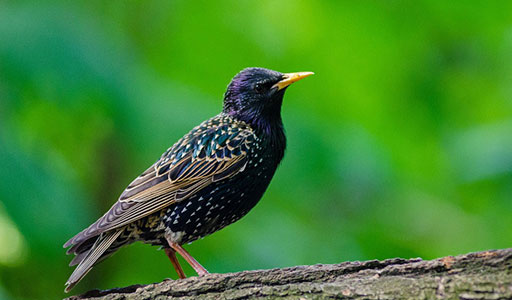Starling Control
Do you need to get rid of starlings? We can help!

Starling Removal Strategies
If you have noticed a problem with starlings on your property, it is time to call in the team of experts at Trutech. Our licensed specialists have the tools and knowledge that it takes to perform effective and humane starling removal and starling control services. At Trutech, we value the lives of all animals, big or small. Our starling removal techniques ensure the safety and well-being of each of the animals involved through our environmentally sensitive tactics.
Do not wait until starlings have nested in your attic to call in reinforcement from Trutech. Call our team of experts today and get started solving all of your wildlife maintenance issues. At Trutech, our dedicated specialists are committed to helping you regain your peace of mind thanks to a starling-free home!
Starling Problem

Signs a Starling is on Your Property
Starlings are small birds native to many parts of North America, especially the northern United States and parts of Canada. Starlings typically have dark blue and black feathers with spots and orange feet. In the wild, starlings are excellent at mimicking sounds that they hear in nature and the calls of other birds. Starlings feed off of vegetation, potentially destroying your landscaping and gardens. Excessive starling defecation can damage building materials. Most commonly, starlings will build nests in your home’s attic or vents. These nests are constructed of grasses, weeds, and leaves and are the resting place for starling’s and their eggs.

Dangers of Starling Infestation
Starlings are considered agricultural pests because of the damage they cause to crops and berries. This affects backyard gardeners as well. In addition, starlings hog local supplies of insects, pushing out other, more desirable bird species. Starling droppings can also contain disease-causing bacteria and viruses, including salmonella and histoplasmosis.
Humane Starling Removal & Control Strategies

Entry into property
These birds often nest in yards if they find attractive spots in trees or along buildings. Once established, their large and intrusive communities entirely take over the area. This cycle has allowed starling populations to keep growing.

Trapping & Removal
Box traps can be used to catch individual starlings, but there are usually so many of the birds in a given location that their effectiveness is negligible. The best way to rid a property of the pests is to contact the animal control specialists at Trutech. These experienced, trained technicians can remove the starling problem safely and completely.

Prevention & Exclusion
The key to preventing starling infestations is eliminating nesting opportunities. That means screening or covering any openings or crevices the birds might use as homes. These can be in trees, around eaves, or even inside dryer, bathroom, and oven vents. To avoid further problems with starlings, check vent coverings periodically and ensure that they are working properly. Birds can fall from vents into open spaces below and become trapped indoors.


